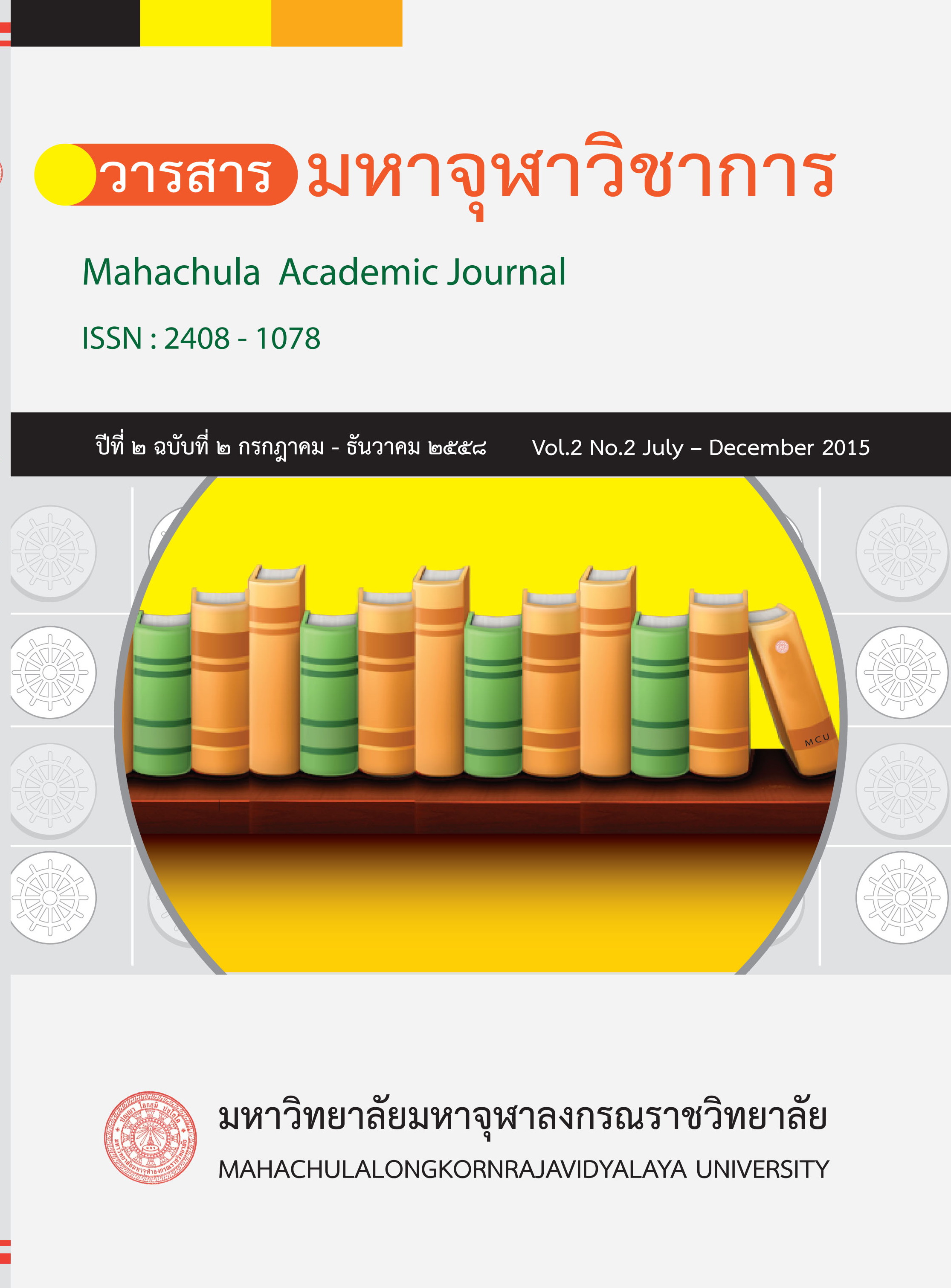Voice patterns of Buddhism propogration
Main Article Content
Abstract
There is actually a research on “Voice Patterns for Buddhist propagation” which has three objectives. They consist of 1) for study the conceptual theories about the voice for communication, 2) for study the conceptual theories about the voice according to the Buddhist scriptures, and 3) for presenting the formations of the voice to propagate the Buddhism.
The finding are as follow : Its results are found that the voice pattern in the Buddhism is divided into the four formations. They are:
- The normal voice
The formations of using the voice have the important aspects to express
the general or natural voice for propagating in Buddhism. The general voice is
the most proper to support the Buddhism in many types-lecturing Dhamma and
giving sermon
- The imitating voice
The formations of using the voice have the aspects to express the imitated sounds which stress the high, low, or middle sounds, including the pitching, echo, or rhythm. These depend upon the fictions of the stories which were being told at a moment.
- The dubbing voice
The formations of using the voice have the aspects in the dubbing sounds which are used and presented Dhamma with the characters in the plays, e.g. Jataka,Dhammapata or Dhammatales. The used voice stands for characters.
- The mixed formations of using the voice
The formations of using the voice have the three mixed aspects of the sound. Many different types of using voice which consist of the general, imitating, and dubbing sounds are joined together in the same dhamma show for giving the sermon. They are assumed that the styles of showing Dhamma by the mixed formations of using the voice neatly. The topic of Dhamma and its contents are propagated. ng the voice for propagating it by the four formations in the Buddhism as said above.
Article Details
References
ชุติมา แก้วเนียม. อบรมเชิงปฏิบัติการ การออกเสียง. เอกสารประกอบการบรรยาย วิชา Introduction to Westtern Music. คณะศิลปะศาสตร์: มหาวิทยาลัยอุบลราชธานี, ๒๕๔๕.
พระธรรมกิตติวงศ์ (ทองดี สุรเตโช). พจนานุกรมเพื่อการศึกษาพุทธศาสน์ คำวัด. พิมพ์ครั้งที่ ๓. กรุงเทพมหานคร: ธรรมสภา, ๒๕๕๑.
พระธรรมปิฎก (ประยุทธ์ ปยุตฺโต). พจนานุกรมพุทธศาสน์ ฉบับประมวลศัพท์. พิมพ์ครั้งที่ ๑๗. กรุงเทพมหานคร: โรงพิมพ์พระพุทธศาสนาของธรรมสภา, ๒๕๕๔.
พระพรหมบัณฑิต (ประยูร ธมฺมจิตฺโต). อานุภาพพระปริตร. กรุงเทพมหานคร: โรงพิมพ์มหาจุฬาลงกรณ์ราชวิทยาลัย, ๒๕๔๘.
มหาจุฬาลงกรณราชวิทยาลัย. พระไตรปิฎกภาษาไทย ฉบับมหาจุฬาลงกรณราชวิทยาลัย. กรุงเทพมหานคร: โรงพิมพ์มหาจุฬาลงกรณราชวิทยาลัย, ๒๕๓๙.
วิรัช ลภิรัตนกุล. วาทนิเทศและวาทศิลป์ : หลักทฤษฎีและวิธีปฏิบัติยุคสหัสสวรรษใหม่. พิมพ์ครั้งที่ ๓ ฉบับสมบูรณ์ ปรับปรุงเพิ่มเติมใหม่. กรุงเทพมหานคร: สำนักพิมพ์แห่งจุฬาลงกรณ์มหาวิทยาลัย, ๒๕๔๓.
สวนิต ยมาภัย. หลักการพูดขั้นพื้นฐาน. พิมพ์ครั้งที่ ๙. งานส่งเสริมการผลิตตำรา: ภาควิชาวาทการคณะนิเทศศาสตร์ จุฬาลงกรณ์มหาวิทยาลัย, ๒๕๓๘.
สมชัย ศรีนอก. นิเทศศาสตร์เชิงพุทธ. กรุงเทพมหานคร: โรงพิมพ์ มหาวิทยาลัยมหาจุฬาลงกรณราชวิทยาลัย, ๒๕๕๕.
อริยะ สุพรรณเกษัท. พัฒนา I.Q.E.Q>M.O.และสมาธิ ด้วยพลังคลื่นเสียง. กรุงเทพมหานคร: โรงพิมพ์มหาจุฬาลงกรณราชวิทยาลัย. ๒๕๔๕.
อรวรรณ ปิลันธน์โอวาท. กลยุทธ์การสื่อสารเพื่อการโน้มน้าวจิตใจ. พิมพ์ครั้งที่ ๔. กรุงเทพมหานคร: สำนักพิมพ์จุฬาลงกรณมหาวิทยาลัย, ๒๕๓๗.


